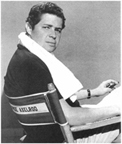 Most folks who know George Axelrod remember him for his play (and the movie Billy Wilder made from it), The Seven Year Itch.
Most folks who know George Axelrod remember him for his play (and the movie Billy Wilder made from it), The Seven Year Itch.
But his career took many turns. After a stint in the Army Signal Corps during World War II, the native New Yorker found gigs writing for radio and contributed material to comedians, including Martin and Lewis, before hitting it big on Broadway and moving on to write for television and motion pictures (he wrote the screenplays for Phffft!, Breakfast At Tiffany’s, and the original version of The Manchurian Candidate, among many others).
 Axelrod also authored three novels: Beggar’s Choice (1947), a role-reversal comedy that finds a novelist whose racy tome gets banned in Boston and New York turning instead to domestic service when he is hired to cook for a well-to-do Connectict family, and his wife takes on chauffeur duties, Blackmailer (1952), a hardboiled mystery set in the world of New York publishing, and Where Am I Now When I Need Me? (1971), a farce that skewers both the publishing industry and Hollywood.
Axelrod also authored three novels: Beggar’s Choice (1947), a role-reversal comedy that finds a novelist whose racy tome gets banned in Boston and New York turning instead to domestic service when he is hired to cook for a well-to-do Connectict family, and his wife takes on chauffeur duties, Blackmailer (1952), a hardboiled mystery set in the world of New York publishing, and Where Am I Now When I Need Me? (1971), a farce that skewers both the publishing industry and Hollywood.
We’ve read about a quarter of Axelrod’s first two titles. We started Beggar’s Choice a few months back and put it aside not because we didn’t find it engaging, but because some title or other we’d placed on hold at the library finally arrived, and we had to undertake that one instead. We’ll definitely return to Axelrod’s first novel, though we’re not prepared to say just when.
 And a just an hour or so, while enjoying the beautiful spring weather in Union Square Park, we ripped through the first forty pages of Blackmailer (which was reissued not long ago by Hard Case Crime — a publishing house of which we are big supporters — though we were reading the original edition pictured here), which is a snappy thriller involving one Richard Sherman, a partner in a low-rent publishing concern that survives mostly on the sales of crosswod puzzle books whose life is turned upside down when a beautiful dame turns up in his office offering to sell him the final completed work by a hot-shot author who died just months before. Trouble is, she’s not exactly forthcoming about how she got her hands on this desirable piece of goods, and his company is not exactly the kind of house that would generally have a shot at publishing such a hot — in every sense of the word — property.
And a just an hour or so, while enjoying the beautiful spring weather in Union Square Park, we ripped through the first forty pages of Blackmailer (which was reissued not long ago by Hard Case Crime — a publishing house of which we are big supporters — though we were reading the original edition pictured here), which is a snappy thriller involving one Richard Sherman, a partner in a low-rent publishing concern that survives mostly on the sales of crosswod puzzle books whose life is turned upside down when a beautiful dame turns up in his office offering to sell him the final completed work by a hot-shot author who died just months before. Trouble is, she’s not exactly forthcoming about how she got her hands on this desirable piece of goods, and his company is not exactly the kind of house that would generally have a shot at publishing such a hot — in every sense of the word — property.
What’s more, a big theatrical agent has contacted him via the mail, offering to sell Sherman the same book. Whom to believe?
Things go from bad to worse when a couple of tough guys show up at Sherman’s apartment, subjecting him to a thorough beating and breaking apart or cutting to shreds every single one of his possessions that could possibly be hiding … well, hiding what? The author’s manuscript? They don’t say (they’re not talkative types).
As we said, we’re about forty pages in — a quarter of the way through this quick pulpy read — and we’re sufficiently hooked to stay with it till the big finish (it’s a reasonably safe assumption that there will be a big finish).
We find the disparity between these two covers striking, don’t you? You’d never guess, to look at them, that they were written by the same author.
